
|
May 09, 2022
Real Threats to Biodiversity and Humanity
By Paul Driessen

References to climate change almost guarantee funding, even for research topics of little interest beyond academia and eco-activists. Polls reveal that most people worry most about energy and food prices, crime, living standards, Putin’s war on Ukraine, and increasing efforts to control their lives.
A recent study by Rutgers University scientists sought to determine how much diversity is required among bee species to sustain wild plant populations. They concluded that ecosystems rely on many bee species to flourish - and “biodiversity is key to sustaining life on Earth,” especially with many species “rapidly going extinct due to climate change and human development.”
US Geological Survey wildlife biologist Sam Droege says wild bees are generally “doing fine.” However, they definitely face challenges, primarily due to habitat loss, disease, and competition from managed honeybees and bumblebees - not to pesticides, since most wild bee species don’t pollinate crops.
That brings us to one of Wokedom’s favorite topics: intersectionality - in this case, actual connections among bees, climate change, habitat losses, and threats to our energy, living standards, and freedoms.
Simply put, the gravest threat to wildlife habitats and biodiversity (and to people’s rights, needs, and living standards) is not climate change. It is policies and programs created, implemented, and imposed in the name of preventing climate change.
Let’s examine habitat and biodiversity threats - without asking whether any climate changes today or in the future are still primarily natural, or are now driven by fossil fuels. Let’s just look at what purported solutions to the alleged “climate crisis” would likely do to the planet and creatures we love. In reality:
The most intensive land use - and thus greatest habitat destruction - is from programs most beloved, advocated, and demanded by rabid greens: wind, solar, biofuel and battery energy, and organic farming.
Team Biden is still intent on getting 100% hydrocarbon-free electricity by 2035. It wants to eliminate fossil fuels throughout the US economy by 2050: no coal or natural gas for electricity generation; no gasoline or diesel for vehicles; no natural gas for manufacturing, heating, cooking or other needs.
America’s electricity demand would soar from 2.7 billion megawatt-hours per year (the fossil fuel portion of total US electricity) to almost 7.5 billion MWh by 2050. Substantial additional generation would be required to constantly recharge backup batteries for windless, sunless periods. Corn-based ethanol demand would disappear, but biofuel crops would have to replace petrochemical feedstocks for paints, plastics, pharmaceuticals, cosmetics, cell phones, wind turbine blades, and countless other products.
This is just for the USA. Extrapolate these demands to the rest of a fossil-fuel-free developed world ... to China and India ...and to poor countries determined to take their rightful places among Earth’s healthy and prosperous people - and “clean, green” energy requirements become monumental, incomprehensible.
We’re certainly looking at tens of thousands of offshore wind turbines, millions of onshore turbines, billions of photovoltaic solar panels, billions of vehicle and backup battery modules, and tens of thousands of miles of new transmission lines. Hundreds of millions of acres of US farmland, scenic areas, and wildlife habitats would be affected - blanketed with enormous industrial facilities, biofuel operations, and power lines.
Add in the enormous and unprecedented mining, processing, and manufacturing required to make all these energy-inefficient technologies - mostly outside the United States - and the land use, habitat loss, and toxic pollution would gravely threaten people, wildlife, and the planet.
Let’s take a closer look, now just from a US perspective, but knowing these are global concerns.
Solar power. 72,000 high-tech sun-tracking solar panels at Nevada’s sunny Nellis Air Force Base cover 140 acres but generate only 32,000 MWh per year. That’s 33% of rated capacity; 0.0004% of 2050 US electricity needs. Low-tech stationary panels have far lower efficiency and generating capacity, especially in more northern latitudes. Meeting 2050 US electricity needs would require Nevada sunshine and nearly 235,000 Nellis systems on 33,000,000 acres (equal to Alabama).
Triple that acreage for low-tech stationary panels in less sunny areas. For reference, Dominion Energy alone is planning 490 square miles of panels (8 times Washington, DC) just in Virginia, just for Virginia. Then add all the transmission lines.
Wind power. 355 turbines at Indiana’s Fowler Ridge industrial wind facility cover 50,000 acres (120 acres/turbine) and generate electricity just over 25% of the time. Even at just 50 acres per turbine, meeting 2050 US power needs would require 2 million 1.8-MW wind turbines, on 99,000,000 acres (equal to California), if they generate electricity 25% of the year.
But the more turbines (or solar panels) we need, the more we have to put them in sub-optimal areas, where they might work 15% of the year. The more we install, the more they reduce wind flow for the others. And some of the best US wind zones are along the Canada-to-Texas flyway for migrating birds - which would mean the massive, unsustainable slaughter of cranes, raptors, other birds, and bats.
Go offshore, and even President Biden’s call for 30,000 MW of electricity (2,500 monster 12-MW turbines) wouldn’t meet New York State’s peak summertime electricity needs.
Biofuels and wood pellets. America already grows corn in an area larger than Iowa, to meet current ethanol quotas. Keep-fossil-fuels-in-the-ground lobbyists need to calculate how many acres of soybeans, canola, and other biofuel crops would be needed to replace today’s petrochemical feedstocks; how much water, fertilizer, labor, and fuel would be needed to grow harvest and process them; and how much acreage would have to be taken from food production or converted from bee and wildlife habitat.
Climate activists also approve of cutting down thousands of acres of North American hardwood forests - nearly 300,000,000 trees per year - and turning them into wood pellets, which are hauled by truck and cargo ship to England’s Drax Power Plant. There they are burned to generate electricity so that the UK can “meet its renewable fuel targets.” And that’s just one “carbon-neutral” power plant. That’s one year to slash and burn the fuel, and fifty years to regrow replacement trees. This is not green, sustainable energy.
Organic farming. Environmentalists dream of converting all US (and even all global) agriculture to 100% organic. That would further reduce wildlife habitats - dramatically - especially if we are to simultaneously eliminate world hunger ... and replace petrochemicals organically.
Organic farms require up to 30% more land to achieve the same yields as conventional agriculture, and most of the land needed to make that happen is now forests, wildflower fields, and grasslands. Organic farmers (and consumers) also reject synthetic fertilizers, which means more land would have to be devoted to raising animals for their manure unless human wastes are used. More lost wildlife habitat.
They reject modern chemical pesticides that prevent billions of tons of food from being eaten or ruined but utilize toxic copper, sulfur, and nicotine-based pesticides. They even reject biotechnology (genetic engineering) that creates crops that are blight-resistant, require less water, permit no-till farming, need fewer pesticide treatments, and bring much higher yields per acre. Translation: even less wildlife habitat
There are alternatives, of course. Government mandates and overseers could require that “average” American families live in 640-square-foot apartments, slash their energy use, ride only bicycles or public transportation, and fly only once every few years. They could also switch us to “no-obesity” diets.
Indeed, “scientists” are again saying we “common folks” could “reduce our carbon footprints” by eating less beef and chicken, and more insect protein, ground-up bugs - or roasted bumblebees. Or we could just reduce the number of “cancerous, parasitic” humans. (Perhaps beginning with wannabe overseers?)
May 04, 2022
Green hypocrisy kept quiet
_thumb.png)
Enlarged
See the 50 failed predictions here.

Image from here.
One of those big bad energy companies has been found guilty of killing 150 rare eagles. You might have missed the story because it wasn’t headline news around the world, which may have something to do with the company being a darling of the renewables movement rather than an oil company and it was wind turbines, not a pipeline rupture or tanker leak, that did the damage. But wind turbines are, indeed, making bird salad. The US government has finally noticed that putting giant spinning blades in bird migratory routes is causing slaughter, especially of large raptors. Not that the wrist slap is likely to put a stop to it.
The impact to bird populations is very serious, as a new study has pointed out.
“Of California’s 23 vulnerable bird species studied (barn owls, golden eagles, road runners, yellow-billed cuckoos...), scientists have found 11 are now experiencing at least a 20% decline in their population growth rates because wind turbines and solar panels are killing them and/or destroying their limited-range habitat.”
Great Golden Eagles, Batman. Can these energy sources, that use so many resources to deliver so little power in such an unreliable way with such a hideous waste-disposal issue at the end of their rather fleeting lives, also be an environmental catastrophe while operating? Are the greens’ favourites the worst imaginable choice in virtually every way? And in California?
Yes, yes and yes. And while you can’t make an omelette without breaking eggs, there are some species whose eggs you cannot legally break for good reason. As the study in question says,
“We assessed the vulnerability of populations for 23 priority bird species killed at wind and solar facilities in California, USA. Bayesian hierarchical models suggested that 48% of these species were vulnerable to population-level effects from added fatalities caused by renewables and other sources.”
And yes, it’s enough to put you to sleep but then shake you violently awake again. Especially that business about “population-level effects”.
“Effects of renewables extended far beyond the location of energy production to impact bird populations in distant regions across continental migration networks. Populations of species associated with grasslands where turbines were located were most vulnerable to wind. Populations of nocturnal migrant species were most vulnerable to solar, despite not typically being associated with deserts where the solar facilities we evaluated were located.”
You mess with nature and bad things happen, apparently. And suddenly the remarkable features of hydrocarbon fuels, namely their energy density, ease of transportation, small footprint, safe storage and so on require a second look...don’t they?
Probably not. As we’ve indicated before, support for nuclear power is something of a sanity test for those who absolutely loathe fossil fuels, and so is awareness that this sort of ecological carnage is a disaster in real as well as PR terms. But it’s a test notable for its high failure rate among climate alarmists.
We mentioned golden eagles above because, as Robert Bradley wrote on Master Resource,
“For decades, the American Wind Energy Association (now part of the American Clean Power Association) has dismissed the ‘avian mortality problem’ as little different than everyday deaths of birds from cats and windows. The Sierra Club echoes this argument in ground-zero wind growth states such as Michigan.”
And while, as he says, it was always a feeble response given how poorly wind power performs, it’s especially so because “It is an open secret was that golden eagles are the particular victims of industrial wind, which inspired a Sierra Club official to dub the technology the ‘Cuisinarts of the Air.’’” Ouch. As Bradley adds, “thus the joke: ‘When is an environmentalist not an environmentalist? ... When it comes to windpower.’”
The firm that recently fessed up to killing eagles is called ESI, which is a wholly-owned subsidiary of NextEra Energy Resources which touts itself in the predictable modern way. “Fessed up” is a term here meaning pled guilty in court and accepted fines and restitution exceeding $8 million after it was shown to have ignored warnings from the US Fish and Wildlife Service not to build turbines in high-risk locations. But why would they heed the warnings since the federal government paid them to do it; Bradley quotes a U.S. Department of Justice press release that includes:
“According to the information filed in this case… ESI and its affiliates began commercial operations at new facilities on a schedule intended to meet, among other things, power purchase agreement commitments and qualifying deadlines for particular tax credit rates for renewable energy, and with production amounts not impacted by avoidance and minimization measures that might have been required under an eagle take permit. ESI and its affiliates received hundreds of millions of dollars in federal tax credits for generating electricity from wind power at facilities that it operated, knowing that multiple eagles would be killed and wounded without legal authorization, and without, in most instances, paying restitution or compensatory mitigation...”
Still, $8 million is a stiff fine, right? Well, not really. As Gregory Wrightstone observed over at CO2Coalition.org, ESI took steps that did, predictably, kill at least 150 bald and golden eagles at 50 facilities without getting the necessary permits. And “Why would ESI simply fail to do the paperwork that is regularly a part of the process for permitting wind facilities? The answer: money, and a lot of it… This $8 million settlement appears to be the cost of doing business for ESI in order for them to cash in on the Big Wind green energy scam.” Seems incentives matter after all. And what sort of incentives are these?
“The legalized slaughter of eagles and other large birds of prey was legitimized under the Obama administration and continues today. At the time, it was estimated that nearly 600,000 birds of all types were killed by the much smaller wind footprint at that time, including 83,000 hunting birds such as hawks, falcons and eagles. Unknown to most citizens is the fact that the FWS [the U.S. Fish and Wildlife Service] has established a “take limit” for wind energy companies to kill bald eagles. This would be similar to a bag limit for a hunter. However, hunters dare not as they are not of the protected class and would be subject to a maximum fine of $250,000 or two years of imprisonment for a felony conviction. FWS regularly imposes fines on oil companies and electric transmission firms for inadvertent deaths of bald eagles, all the while giving its seal of approval to green-induced eagle carnage of a grand scale from turbines.”
See the joke about an environmentalist above. But as Wrightstone concludes his piece, “Those promoting the flawed idea that a complete transition from fossil fuels to an economy driven solely by wind and solar need to ask themselves, ‘At what cost?’” And what other cause would they say legitimizes this mass killing of such birds?
Apr 22, 2022
Happy Earth Day - Real Air Pollution issues solved, CO2 a benefit not a danger
It is perfectly reasonable to work to ensure clean air and water and towards conservation of our resources. I have always considered myself a conservationist and environmentalist. In the post war boom, we had problems with air pollution from factories, coal plants, cars, inefficient home heating systems and incinerators in apartments. We had air quality issues with pollutants like soot, SO2, ozone, hydrocarbons, NOx, and lead, We set standards that had to be met by industry and automakers. We have the cleanest air in my lifetime and in the world today.
The term “carbon pollution” is a deliberate, ambiguous, disingenuous term, designed to mislead people into thinking carbon dioxide is pollution. It is used by the environmentalists to confuse the environmental impacts of CO2 emissions with the impact of the emissions of unwanted waste products of combustion. The burning of carbon-based fuels (fossil fuels - coal, oil, natural gas - and biofuels and biomass) converts the carbon in the fuels to carbon dioxide (CO2), which is an odorless invisible gas that is plant food and it is essential to life on the planet.
Because the burning of the fuel is never 100% efficient, trace amounts of pollutants including unburnt carbon are produced in the form of fine particulates (soot), hydrocarbon gases and carbon monoxide. In addition, trace amounts of sulfur oxides, nitrogen oxides and other pollutant constituents can be produced. In the US, all mobile and industrial stationary combustion sources must have emission control systems that remove the particulates and gaseous pollutants so that the emissions are in compliance with EPA’s emission standards. The ambient air pollutant concentrations have been decreasing for decades and are going to keep decreasing for the foreseeable future because of existing non-GHG-related regulations.
-------------------------------------------
To ensure that the air is safe to breathe, the Clean Air Act (CAA) requires the EPA to set National Ambient Air Quality Standards (NAAQS) for the most harmful ubiquitous air pollutants. The NAAQS are set at levels requisite to protect human health and welfare with an adequate margin of safety. These ubiquitous pollutants are called the Criteria Air Pollutants and include: fine particulates (PM2.5), larger particulates (PM10), carbon monoxide, sulfur oxides, nitrogen oxides, lead, and ozone (O3). The CAA also required States to develop plans to manage the emissions and concentrations of these pollutants so that the NAAQS are attained in every part of the US.
As a result, most areas of the US attain the NAAQS for all the pollutants most of the time. The ambient concentrations have been decreasing for decades (see charts below) and are going to keep decreasing for the foreseeable future because of existing regulations. For the few areas of the US that are in violation of a NAAQS, the States have (or are in the process of) developed plans to attain them in the near future.
It needs to be noted that the current healthy air quality in the US has been achieved with existing regulations that have nothing to do with climate or CO2 regulations.
The EPA and the environmentalists have claimed that the co-benefits of CO2 reductions justify the enactment of CO2-reduction regulations. These co-benefits assume that deaths and other health effects due to exposures of PM2.5 and O3 will be avoided. This assumption is erroneous because the relationships that EPA uses to calculate the purported health effects are based on epidemiology studies that used flawed statistical methods. When the proper methods are used, no causal relationship is found between either PM2.5 or O3 and premature mortality or other serious health effects at levels currently measured in the US.
The environmentalists also claim that rising temperatures caused by increasing CO2 levels will exacerbate PM2.5 and O3 air pollution. This claim is flawed for a number of reasons.
First, as detailed elsewhere, there is no convincing evidence that increasing CO2 levels has caused global temperatures to rise. Second, there is no consistency in EPA model predictions that increasing temperatures will actually cause PM2.5, which is purported to cause most of the health effects and mortality, to increase. In fact, the country by country PM2.5 from NASA and the WHO shows the U.S. with reliance on clean natural gas shows the lowest small particulate count along with Scandinavia and Australia in the world.
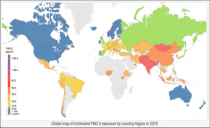
Enlarged
Although there is general agreement that higher temperatures will cause increased O3 formation, that only occurs if emissions of O3 precursors remain unchanged. The reality in the US is that O3 precursors have been and will continue to decrease for the foreseeable future. EPA has shown ozone has actually decreased decreased 33% since 1980 and PM2.5 decreased 41% since 2000.
In addition, if for any reason, concentrations of any Criteria Pollutant ever went up so as to exceed its NAAQS anywhere in the Country, the CAA provides mechanisms that are already in place requiring the States to revise their plans to offset any increases.
Finally, as discussed above, the basic premise that PM2.5 and O3 are causing serious health effects in the US at their current levels is simply false
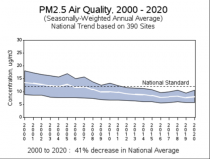
Enlarged
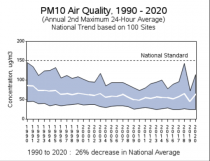
Enlarged
Sulfur dioxide was a few decades ago in the news for its implication in acid rain. When sulfur dioxide reacts with rain or fog, sulfuric acid forms and becomes acid rain or mist (smog). Smog event in Donora PA in 1948 - 7,000 of the 14,000 population experienced damaged lungs, 20 died. The incident led to a series of clean air regulations and culminated in the US Clean Air Act of 1970. Acid rain continued to be a concern into the 1980s before measures were invoked that reduced SO2 by 94%., an environmental success story.
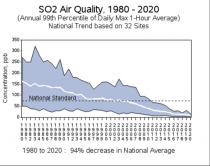
Enlarged
Significant improvements with other pollutants were observed with a 64% reduction for nitrogen oxides, 86% for lead and 81% for carbon monoxide.
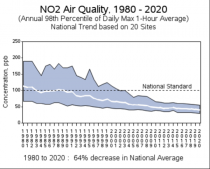
Enlarged
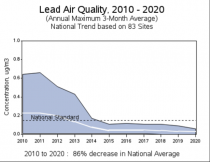
Enlarged
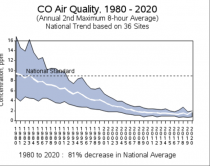
Enlarged
CARBON DIOXIDE THE GAS OF LIFE
Note that carbon dioxide is not listed as a criteria pollutant. It is essential for all plant life. We breathe in 400ppm CO2 and breathe out 40,000 ppm. It is pumped into greenhouses. A greening of the planet has occurred as a result of the increases the last century. The Sahara desert has shrunk by 8%!
This image shows the change in leaf area across the globe from 1982-2015.
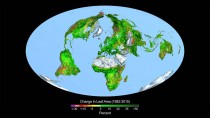
Enlarged
Credits: Boston University/R. Myneni
Carbon Dioxide has blessed the world with increased food.
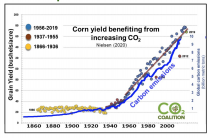
Enlarged
Dr. Craig Idso in Master Resource writes ”Perhaps the most well-known and significant biological benefit of Earth’s rising atmospheric carbon dioxide (CO2) concentration is enhanced plant production. Over the past five decades literally thousands of laboratory and field-based studies have been conducted to examine growth-related responses of plants at higher levels of atmospheric CO2. These CO2-enrichment studies, as they are called, are near unanimous in what they have found - increased levels of CO2 significantly enhance plant photosynthesis and stimulate growth.”
The use of fossil fuels to help regulate heat and cold, has led to greater prosperity and reduced poverty. Deaths from weather extremes have declined since 1920.
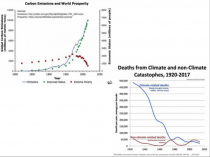
Enlarged
By the way, perversely, when families can’t afford to pay for the energy (heating oil, gas or electricity) to heat their homes in winter as will be the case with the forced change to unreliable wind and solar, they revert to burning wood. This introduces the particulate matter and other ‘pollutants’ we have worked so hard to remove at the source. Some use kerosene heaters and some deadly fires result.
“In searching for a new enemy to unite us, we came up with the idea that pollution, the threat of global warming...would fit the bill...It does not matter if this common enemy is “a real one or....one invented for the purpose.” Quote by the Club of Rome “First Global Revolution” 1991.
“We have got to ride the global warming issue. Even if the theory of global warming is wrong, we will be doing the right thing in terms of economic policy and environmental policy.” Timothy Wirth, U.S. Senator, president of the United Nation’s Foundation.

Enlarged

Enlarged
Apr 18, 2022
Met Office Changed Global Temperatures to Add 14% to Warming
Chris Morrison

Enlarged
Satellite data show that global warming started to run out of steam two decades ago, but the U.K. Met Office’s record of surface temperature from 1975 was boosted by 14% at the end of 2020. At the same time, the period between 1880-1975 was cooled. The move accentuates the rise in the global temperature recorded in the 1980s and 1990s that forms the basis of much of the current hysteria about the so-called climate emergency.
The disclosure of the apparent warming and cooling is contained in the latest State of the Climate report from Emeritus Professor Ole Humlum of the University of Oslo, and published by the Global Warming Policy Foundation. Professor Humlum says the post-1975 warming is about +0.1C and the pre-1975 cooling about -0.1C. The version-change to the fifth HadCRUT Met Office database “conveys the impression of a somewhat more rapid global temperature increase following the relatively cold period terminating around 1975”. When the Met Office first announced the change in December 2020, it admitted to 0.16C extra warming, although it didn’t give specifics about cooling and warming either side of the 1975 mark.
Professor Humlum also draws attention to significant retrospective changes in the American GISS surface temperature record. The graph below shows the effect of the changes made since May 2008 on the monthly temperature record, with increases in red and decreases in blue. As with HadCRUT, the changes warm the early part of the record, cool the period from 1900 to 1970, and heat up the later recordings.

Enlarged
Humlum notes that the changes in annual values are often quite substantial, ranging from about +0.15C to -0.15C. He goes on to note that the temperature difference between 1915 and 2000 increased from 0.45C to 0.67C. “This represents an increase of about 49% over this period, meaning that about half of the apparent global temperature increase from January 1910 to January 2000 is due to administrative adjustments to the original data made since May 2008” he writes.
Recent boosts to global temperatures databases are of course very helpful to activists in the media and politics keen to report ‘record’ warm years at a time when accurate satellite data reveal a pause of 88 months (and counting). In addition, work continues across a number of fronts to promote the climate emergency agenda, including extreme weather events.
Last week, the BBC reported that southern African storms were fuelled by climate change. According to the BBC, the results of a study from the World Weather Attribution group show that damage inflicted by storms in the region was exacerbated by global warming. According to the press release, the group used “computer simulations” to arrive at its findings. The BBC ran the scare story, without a byline, despite noting that “the precise contribution of climate change to the event could not be quantified, due to the absence of comprehensive historical records of rainfall in the region”.
In fact, attributing single episodes of bad weather to long-term changes in the climate is highly unscientific, since it is just an opinion. In 2014, Associate Professor Jennifer Fitchett from the University of the Witwatersrand published a paper in which she said she found “no statistically significant trends in the frequency of tropical cyclone landfalls over Madagascar and Mozambique over the past six decades”. Furthermore, much of the perceived changes in storm numbers could be attributed to recent improvements in storm detection methods.
Professor Humlum’s excellent and measured climate report provides further context in which to evaluate the constant media scare stories about hurricane and cyclones.

Enlarged
The above graphs plot accumulated cyclone energy (ACE), as used by the U.S.-based National Oceanic and Atmospheric Administration (NOAA). Humlum notes that ACE gives a measure of the damage potential of an individual storm or a season. If climate change is affecting the southern hemisphere, and causing more severe problems in southern Africa, the trend does not yet appear to have shown up in the actual data. Overall, Humlum notes, “existing records do not suggest any abnormal cyclone activity in recent years”.
Another fashionable scare story is the loss of snow, particularly in the Alps, a favoured winter holiday destination of many Guardian, BBC and Extinction Rebellion supporters. In 2017, the Guardian reported that according to “experts” Alpine ski resorts could lose up to 70% of their snow cover by 2100. Last year, Justin Rowlatt reported on Panorama that snowy U.K. winters could become a thing of the past.

Enlarged
Back on Planet Reality, the thin blue lines above, show weekly northern hemisphere snow data, while the thicker blue line shows a 53 week average. There is practically no change going back 50 years
Humlum concluded: “A year ago, I warned that there was great risk in using computer modelling and immature science to make extraordinary claims. The empirical observations I have reviewed show very gentle warming and no evidence of a climate crisis.”
Chris Morrison is the Daily Sceptic’s Environment Editor
Apr 10, 2022
Don’t Look Up!
Paul Driessen
A real rock from outer space (not manmade climate change) is causing perceived rising seas
Paul Driessen, CFACT
In the Netflix movie, Washington politicians “Don’t Look Up” because they prefer to remain oblivious to a special effects meteor that’s about to obliterate Planet Earth. Not surprisingly, the film is really about our refusal to recognize the “existential threat” of “manmade climate change.”
Director Adam McKay recently tweeted, “We’ve got 6-8 years before the climate is so chaotic we [will] live in a permanent state of biblical catastrophe.”
Not to be outdone, UN Secretary General Antonio Guterres called the latest UN climate report “a file of shame, cataloguing the empty pledges that put us firmly on track toward an unlivable world.” Drilling for more oil and gas is “moral and economic madness,” he insisted. If humanity doesn’t stop using fossil fuels, we will be overwhelmed by devastating floods, heat waves, droughts, fires and crop failures.
Global sea levels have already risen “a shocking nine inches,” the PurpleOrange PR Agency proclaimed, promoting a client’s Climate Neutral Certified label, which is designed to channel more money to “authentic, immediate climate action.”
Back on the non-parallel-universe Planet Earth, a truly unlivable world would be one without fossil fuels. Not just to generate electricity, cook food, heat homes and water, and power cars, boats, trains and planes - but for fertilizers and insecticides to grow more food on less land, and for plastics, pharmaceuticals, paints, cosmetics, clothing and other essential products. For us today; for billions more tomorrow.
Fossil fuels to extract and process trillions of tons of raw materials, too, and manufacture the millions of wind turbines, billions of solar panels, billions of battery modules and millions of transmission line towers that would blanket our croplands, scenic areas and wildlife habitats if we didn’t have fossil fuels.
In fact, far worse than a warmer planet with more airborne plant-fertilizing carbon dioxide would be a colder planet with less CO2. That would mean less arable land, shorter growing seasons and much lower crop yields, on top of losses from a devastated Ukraine and sanctioned Russian wheat crops.
(Why is it that Twitter twits never cancel, suppress or even fact-check climate fear porn? Why is it never just climate change, but always climate cataclysms? Why always manmade climate change, as though past natural climate changes never happened? Why do Guterres, Gore, Kerry, Biden and AOC always have to top his, her, hir, ver, zir fellow alarmists in hysteria? Why is the fear-mongering always based on computer models, never on actual data and evidence? Why does it always ignore China’s massive fossil fuel use and greenhouse gas emissions?)
One of the prevalent climate alarm themes is sea level rise.
Back on real Earth, if the DC Swamp inhabitants of 35 million years ago had looked up, they’d have been transfixed in their last moments by a non-special-effects meteor hurtling into what is now Cape Charles, Virginia on the Chesapeake Bay. The 2-mile-wide meteor obliterated and pulverized sediments and bedrock, vaporized plants and animals, sent rock fragments hundreds of miles in every direction, and launched tsunamis into West Virginia’s eastern mountain slopes.
Shattered rock settled back into a crater 4,300 feet deep and 53 miles in diameter. Over the ensuing millennia, river and ocean sediments poured into the crater - and mile-high glaciers pulled 10-million cubic miles of water out of the oceans, burying half of North America, Europe and Asia under trillions of tons of ice. Land under the ice was pressed down, while land outside the glacial zones was lifted up. Then, some 12,000 years ago, the last Pleistocene glaciers began melting.
Oceans slowly rose - some 400 feet! Land masses underwent “isostatic rebound.” Areas that had been under the ice began rising; those that had bulged upward began sinking. In much of the Chesapeake Bay region, post-glacial subsidence is compounded by continued compression of pulverized crater rock - and by the ongoing withdrawal of groundwater from sedimentary aquifers beneath urban and agricultural areas that depend on groundwater.
The aquifers include layers of porous sandstone (with water between sand grains) interspersed among layers of impermeable but water-soaked shale and clay. As water is pumped out of the sandy layers, the shale-clay layers get squeezed by hundreds of feet of overlying rock and sediment, and their water is forced into the sandstones, and then into pumps. The overlying land steadily subsides.
In the Chesapeake Bay area, subsidence averages nearly 3 mm/year; 11.5 inches per century. That’s in addition to almost 4.5 inches per century in isostatic subsidence, plus 7 to 9 inches per century in actual sea level rise. The total perceived sea level rise can be 24 inches per century - although two-thirds of that total has nothing to do with actual sea level rise. Indeed, the Norfolk Naval Station tide gauge at Sewell’s Point shows that the rate of actual sea level rise has not changed since the gauge was installed in 1927.
The situation in Houston-Galveston, Texas, Santa Clara Valley, California, and other places around the globe is similarly complicated, even without post-glaciation issues. To single out actual sea level rise and blame the rise on humans and fossil fuels -is simply disingenuous.
However, salt-water intrusion and coastal flooding are serious, recurrent, growing problems, especially during hurricanes and as more expensive homes are built along coasts. Some communities have slowed subsidence by relocating groundwater pumping stations away from the coast, reducing withdrawal rates, increasing aquifer recharge, or substituting surface water for groundwater. Others have installed sea walls, improved drainage systems, and pipelines to bring water from nearby lakes and rivers. Other options include desalination plants to create more fresh water, recycling household “gray water” to agricultural use, and switching to less water-intensive irrigation methods, as Israel does.
These approaches are far more practical and cost-effective than trying to stop seas from rising any further, like a modern King Canute, by banning fossil fuels, especially if it’s done only in some Western nations.
Meanwhile, inhabitants of Tuvalu, the Maldives and other Pacific islands and coral atolls worry about rising seas due to fossil fuels. However, most of them are increasing in land area, not decreasing ‘ as corals grow, sediments are laid down off their coasts, and volcanic lava flows expand land masses.
Moreover, few of these islands and coral reefs even existed 12,000 years ago, when the Wisconsin Glaciation extracted 400 feet of seawater from the world’s oceans. The islands and atolls began growing as the seas rose. They’ve continued growing with every additional foot of sea level rise since the last Ice Age and the Little Ice Age (1350-1850) - and show no signs of stopping.
Cosquer Cave’s Paleolithic paintings near Marseille, France (the entrance is 115 feet below current sea level) and a Mel Fisher dive team’s discovery of charred tree branches and pine cones from a forest fire 8,400 years ago in 40 feet of water off the Florida coast further attest to steadily rising seas.
Yet, experts tell us. (1) “Snows are less frequent and less deep. The rivers scarcely ever freeze over now. There is an unfortunate fluctuation between heat and cold in the spring, which is very fatal to fruits.” (2) “We were astonished by the total absence of ice in Barrow Strait. I was here at this time [six years ago] still frozen up - and doubts were entertained as to the possibility of escape.” (3) “The Arctic Ocean is warming up, icebergs are growing scarcer, and in some places the seals are finding the water too hot.”
It behooves to take action. Or perhaps not. Quotation (1) is from Thomas Jefferson’s diary, 1799; (2) from Sir Francis McClintock’s ship’s log, 1860; (3) from a Washington Post article, November 2, 1922.
Instead of parroting scare stories - and demanding that fossil fuels be replaced by pseudo-clean, pseudo-renewable energy - it really behooves us to think, analyze, ponder the many ways fossil fuels improve our lives, and demand real evidence instead of GIGO computer models for any supposed climate crisis.
Paul Driessen is senior policy analyst for the Committee For A Constructive Tomorrow (www.CFACT.org), and author of Eco-Imperialism: Green power - Black death and articles on energy, climate and other issues.
|
|
|
|




_thumb.png)
















